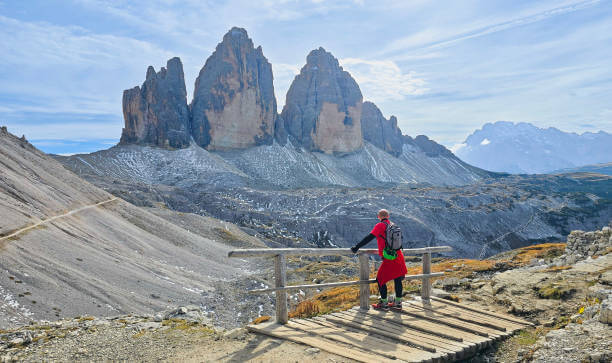The Dolomites are more than just mountains – they are a place full of history and natural beauty. Their pale peaks glow pink at sunrise and create an unreal landscape. But you come here not only for breathtaking views. In 2009, the Dolomites were named a UNESCO World Heritage Site. Hiking here means walking through ancient rock formations, discovering old Ladin traditions, and seeing traces of World War I history along the trails. It’s a journey through time.

A testament to time
250 million years ago, the Dolomites were part of a tropical sea covered in coral reefs. Gradually, tectonic forces turned them into the towering peaks we see today. One of the most magical sights in the Dolomites is enrosadira, when the mountains glow in shades of pink, orange, and red at sunrise and sunset.
You will also be impressed by the striking shapes of the mountains – sharp peaks, towering spires, deep valleys, and rock walls. These dramatic formations create some of the most breathtaking scenery in the world and make the Dolomites a paradise for hikers and nature lovers.
Cultural heritage
The Dolomites have rich traditions. This ancient community has preserved the Ladin language. It is a blend of Rhaetian and Latin influences and can still be heard in Val Gardena and Alta Badia valleys. Here, you will also find tunnels and fortifications from World War I, where Italian and Austro-Hungarian forces engaged in fierce mountain warfare. Today, the region is famous for alpine farming. Generations of farmers are grazing livestock in high-altitude pastures and carefully keeping a balance between agriculture and nature.
Historical sites to see
You can combine your hiking adventure with sightseeing. There are many interesting places in the Dolomites:
Open-air war museums. There are many open-air museums that display the remnants of World War I. Here, you can explore restored trenches, bunkers, and artillery positions. The museum provides informative displays and guided tours that delve into the events that unfolded in these very mountains.
Timeless villages. You can discover more about traditional Ladin architecture in the little villages of San Cassiano and Cortina d’Ampezzo. These settlements offer a glimpse into the region’s cultural heritage, which was formed under the influence of Italian and Austrian cultures. Narrow streets, wooden balconies and colorful facades will move you back in time.
Historic rifugios. Local mountain huts have offered shelter to hikers during hut to hut hiking Dolomites. These rifugios are situated at an elevation of 2,450 meters. Some huts have a rich history – they have been rebuilt and named after notable figures. There are even rifugios that have been accepting visitors for over a century.
Historical hiking routes
You can explore paths that have historical significance. Here are some recommended routes:
The Great War routes. During World War I, the Dolomites became a frontline. These places witnessed intense battles between Italian and Austro-Hungarian forces. Today, the Lagazuoi Tunnels offer hikers a chance to go through tunnels and paths that soldiers once navigated. It’s an exciting chance to have a glimpse into the past.
Ancient trade paths. Centuries ago, the Dolomites were a crossroads for merchants and shepherds. You can go along routes stretching from Lago di Braies in South Tyrol to Belluno in Veneto to repeat these trips.
Pilgrim trails. There are even spiritual journeys in the Dolomites. Let’s take a trail that leads to the Santuario di Monte Santo – in medieval times, it was traversed by pilgrims. Such routes offer both a physical challenge and a unique retreat for reflection.
Tips for hikers
Every visitor should appreciate and protect this cultural and natural place. Here are some basic rules:
- Respect memorial sites. You should understand the significance of memorials and follow posted guidelines. Don’t touch or alter the artifacts you meet on your way.
- Leave no traces. Minimize your environmental impact – stay on designated paths and dispose of waste properly. These rules preserve the mountains for future visitors.
- Support local cultural preservation. Help local communities support artisans and cultural initiatives. Participate in tours and activities that promote the preservation of cultural traditions.
UNESCO encourages the protection of the Dolomites’ fragile beauty and initiatives to manage over-tourism and climate change that still exist. They launch many projects to keep the region for future generations. One of these initiatives is “Noi Dolomiti UNESCO” – it lets locals share their perspectives and actively participate in safeguarding the region’s heritage.
The Dolomites are not only a hiking destination; they are a living museum where every peak, path, and village tells a story of the past. You can follow the trails of soldiers who fought here, admire ancient rock formations, and rest in mountain huts (rifugios). This region beautifully blends nature and history – you will love every minute spent here.

